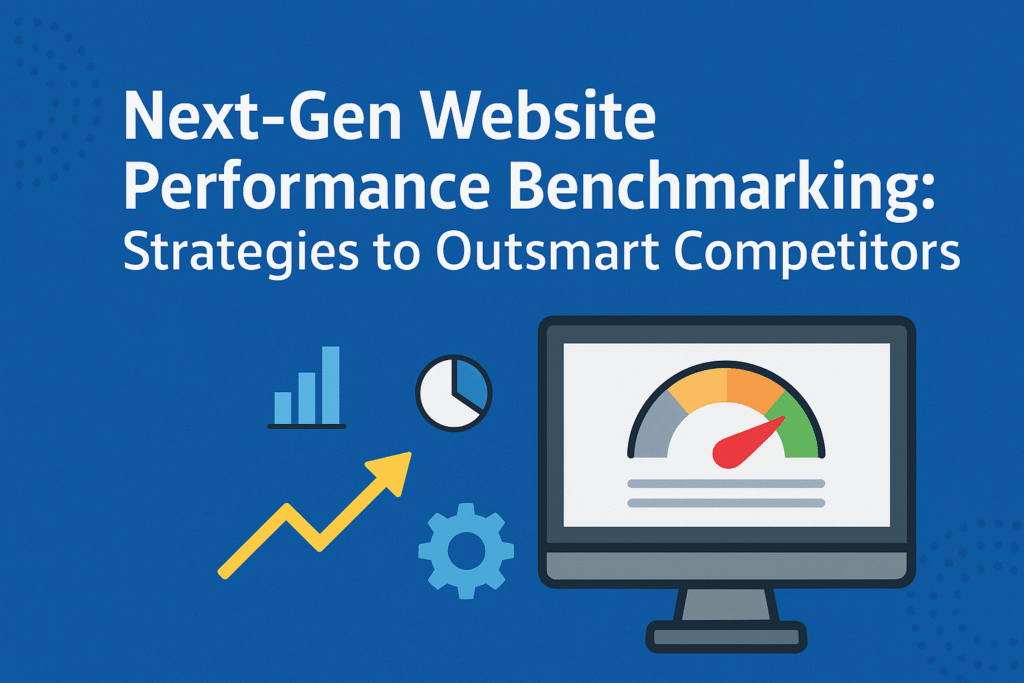Benchmark to the Top: Crush Competitors with Data-Driven Website Insights
Ever wonder why some websites just seem to pull ahead of the rest? It’s not luck. The secret is competitive website benchmarking, looking at how your site performs compared to the top players in your industry. It shows you where you shine, where you lag and where small changes can make a big difference.
We are not talking about random numbers. This is about understanding how fast your pages load, how smooth your site feels to visitors and how easy it is for people to act. Getting this right can change the game for your traffic, engagement, and conversions.
In this guide, we break down a practical approach to website performance benchmarking based on insights from five leading blogs. You’ll see how analyzing competitor page load time metrics and Core Web Vitals can help you outperform competitors and deliver a better experience for your audience.
Why Competitive Website Benchmarking Matters
Understanding how your website stacks up against competitors is more than just curiosity, it’s a strategic move. Competitive website benchmarking gives marketers a clear picture of where their site stands in terms of SEO, user experience, conversions, and overall marketing ROI. When you know how fast your pages load, how smooth interactions feel, and how visitors respond, you can make smarter decisions that drive real results.
Practical guides like Brandwell.ai show how to choose the right competitors and collect meaningful metrics, so you aren’t just comparing numbers for the sake of it. NitroPack emphasizes using KPIs and Core Web Vitals to set clear benchmark thresholds, helping you know when your site is performing well or falling behind. Tools like Last9.io go a step further with regional and device-specific benchmarks, uncovering opportunities you might miss if you only look at global averages.
SaaS reports also highlight the value of composite scoring, weighing trade-offs between uptime and speed to get a balanced view of performance. Shopify’s approach for e-commerce shows that benchmark-driven UX improvements can directly boost revenue. By combining insights across SEO, UX, and conversions, competitive website benchmarking becomes a practical roadmap for outperforming peers and improving every part of your digital presence.
Selecting Your Competitive Set
- Pick the right mix: Start with direct competitors who share your audience and business model. Add aspirational brands to inspire new ideas and spot performance gaps through competitor website performance comparison.
- Focus on relevant metrics: Look at competitor page load time metrics, peer site performance metrics, and competitor UX performance audits. This shows how top sites balance speed, usability, and conversions.
- Industry and regional context: Use industry website performance standards and regional data from tools like Last9.io. Competitor site speed comparison across locations can uncover niche opportunities you might miss.
- Device-specific insights: Compare desktop and mobile experiences. Benchmark competitor site speed and mobile page experience to see where your site might be lagging.
- Actionable benchmarking: This careful selection makes your comparative web performance analysis meaningful and sets up web performance competitive insights you can act on to improve rankings, UX, and conversions.
Key Metrics to Benchmark
When it comes to competitive website benchmarking, knowing which metrics matter is half the battle. The right performance data shows where your site is excelling, where it’s lagging, and how you stack up against peers.
Performance and Speed
Start with the basics: page load times, Time to First Byte (TTFB), and Speed Index. These metrics form the foundation of competitor site speed comparison and help you benchmark competitor site speed accurately. Tools like GTmetrix, PageSpeed Insights, and debugBear (Brandwell.ai) make it easy to gather peer site performance metrics and perform a competitive site speed audit. Faster load times don’t just improve SEO—they directly impact conversion rate and user satisfaction.
Core Web Vitals
LCP (Largest Contentful Paint), INP (Interaction to Next Paint), and CLS (Cumulative Layout Shift) are key for measuring real-world user experience. Tracking competitor Core Web Vitals comparison allows you to see how top sites handle visual stability, responsiveness, and content speed. Combining these metrics with comparative web performance analysis gives a clearer picture of where your site stands.
Uptime and Availability
Downtime affect trust and revenue. Use composite scoring methods, like those in Catchpoint’s SaaS report, to measure availability against industry website performance standards. Benchmarking web performance for uptime ensures your site stays reliable compared to competitors.
User Engagement Metrics
Bounce rate, session duration, and page depth show whether visitors actually stick around. Web performance competitive insights reveal patterns across peer sites, helping you spot where improvements in speed and UX could keep users engaged longer.
Conversion Metrics
Track form completions, cart abandonment, and lead capture rates. Competitor UX performance audits highlight how high-performing sites convert visitors, giving you actionable data for website speed competitor analysis and overall comparative performance auditing.
By monitoring these metrics, marketers can create a clear roadmap to outperform competitors, improve site performance score comparison, and deliver a faster, more engaging experience for every visitor.
Toolstack for Benchmarking
Having the right tools makes competitive website benchmarking actionable and much easier. A few go-to platforms can help you measure performance, compare with peers, and identify areas for improvement.
Google PageSpeed Insights is great for checking Core Web Vitals and seeing both lab and real-world data. Comparing your results to competitors’ competitor Core Web Vitals comparison can show exactly where you lag in LCP, INP, or CLS.
GTmetrix offers detailed waterfall charts and historical trend analysis, making benchmarking web performance against peers simple. You can track competitor page load time metrics and spot recurring bottlenecks in your site or others.
For traffic and technology insights, tools like SimilarWeb and SimilarTech give a clear view of how competitors drive users to their site and which platforms they use. These help with web performance competitor insights and comparative performance auditing.
Catchpoint and Pingdom focus on uptime and multi-location testing. By using composite scoring, you can compare your site’s reliability against industry website performance standards and identify gaps through performance gap analysis.
Finally, Last9.io’s templates let you track benchmarks globally and across devices. These tools make competitor site speed comparison, competitor UX performance audit, and overall website speed competitor analysis practical and repeatable.
Comparative Analysis of Top 5 Blogs
When it comes to competitive website benchmarking, there’s a lot to learn from existing thought leaders. Looking at five top blogs gives us both practical guidance and insights into metrics, tools, and frameworks you can use.
Brandwell.ai – “Benchmark Your Website Against Competitors (Step-by-Step Guide)”
Strengths: Brandwell.ai offers a clear, actionable walkthrough for competitor website performance comparison. Their guide helps with competitor selection and shows how to collect relevant metrics. Using their recommendations, you can run a competitive site speed audit and get started with benchmarking web performance quickly.
Gap: The blog is light on deep KPI thresholds, so it doesn’t show how your scores compare to real-world standards.
NitroPack.io – “13 Metrics to Measure Website Performance in 2025”
Strengths: NitroPack is highly data-driven, focusing on Core Web Vitals benchmarks like LCP, CLS, and INP. It provides competitor Core Web Vitals comparison and real-world stats to help with site performance score comparison.
Gap: The competitive context is limited, so you need to add insights from peer comparisons.
Last9.io – “Website Performance Benchmarks: What You Should Aim For”
Strengths: Offers regional and device-specific benchmarks, web performance competitive insights, and pre-built logging templates for comparative web performance analysis.
Gap: It focuses less on conversion metrics, so you may need other sources for competitor UX performance audit and CRO insights.
Catchpoint.com – “2025 SaaS Website Performance Benchmark Report”
Strengths: Introduces composite scoring for uptime and speed, showing performance gap analysis in SaaS. Great for understanding trade-offs between reliability and speed.
Gap: The data is SaaS-specific and less applicable to e-commerce or content-heavy sites.
Shopify.com – “Website Benchmarking: How To Benchmark Your Website”
Strengths: Perfect for e-commerce, linking benchmark competitor site speed and UX directly to revenue. Helps with website speed competitor analysis and benchmarking against market leaders.
Gap: Less useful for non-retail businesses.
Synthesis
Combine the strengths of all five sources to create an all-in-one approach. Use Brandwell.ai’s step-by-step framework, NitroPack’s KPI benchmarks, Last9.io’s regional and device templates, Catchpoint’s scoring models, and Shopify’s revenue-focused insights. Together, they provide a comprehensive guide for competitor site speed comparison, comparative performance auditing, and web performance competitive intelligence that can be applied across industries.
Building Your Benchmarking Playbook
Creating a competitive website benchmarking playbook doesn’t have to be complicated. Start by defining clear objectives and KPIs—focus on speed, UX, and conversions. Knowing what you want to improve makes every metric actionable.
Next, assemble your toolstack and competitor list. Use GTmetrix, PageSpeed Insights, and debugBear for competitor site speed comparison, and include aspirational and direct competitors for a full comparative web performance analysis.
Collect data across locations and devices to get a true picture of mobile page experience and desktop performance. Then, populate a customized benchmark template, such as Last9.io’s structure, to track peer site performance metrics and competitor Core Web Vitals comparison.
Analyze gaps using a heatmap of impact versus effort to prioritize improvements. Focus first on fixes that boost speed, reduce bounce rates, and improve conversions.
Implement changes iteratively and monitor progress with continuous dashboards. Tracking results lets you see how optimizations affect website speed competitor analysis and overall web performance competitive insights. Finally, report outcomes to stakeholders, connecting site performance gains to real business results, following Shopify’s revenue-focused approach.
This structured approach turns benchmarking from a technical exercise into a strategic marketing tool.
Conclusion
Competitive website benchmarking is more than a technical task—it’s how you turn your site from good to a market leader. By combining actionable frameworks, clear KPIs, and the right tools, you get a real picture of how you perform compared to peers and where to improve.
Bringing together Brandwell.ai’s step-by-step guidance, NitroPack.io’s Core Web Vitals benchmarks, Last9.io’s regional and device templates, Catchpoint’s composite scoring, and Shopify’s revenue-focused metrics gives you a unified playbook. This approach covers competitor website performance comparison, competitor page load time metrics, peer site performance metrics, and web performance competitive insights in one place.
Implement your playbook with disciplined measurement, iterative improvements, and stakeholder-aligned reporting. Monitoring competitor UX performance audits, running benchmark competitor site speed checks, and tracking comparative web performance analysis ensures your efforts translate into real marketing gains.
In 2025 and beyond, benchmarking against market leaders isn’t just a phrase. It’s the roadmap to outperform competitors, improve conversions, and create a website experience that wins users and keeps them coming back.
FAQs
1. What distinguishes competitive benchmarking from basic site speed testing?
Site speed testing measures your site in isolation. Competitive website benchmarking compares your performance against peers, showing where you lead or lag in
2. How many competitors should I include in my benchmarking set?
Focus on a mix of direct rivals and aspirational brands. Too few, and insights are limited; too many, and analysis becomes unwieldy. A set of 5 to 10 is usually manageable for comparative web performance analysis.
3. Which Core Web Vitals metric impacts SEO the most?
LCP (Largest Contentful Paint) is critical because slow loading affects rankings and user experience. Competitor Core Web Vitals comparison can help you see where you stand.
4. How do I account for geographic performance variations?
Use multi-location testing tools and regional benchmarks to capture competitor site speed benchmarking across regions.
5. Can benchmarking tools automatically schedule recurring tests?
Yes, platforms like GTmetrix and PageSpeed Insights allow recurring checks, helping maintain web performance competitive insights over time.
6. How often should I update my benchmark data?
Quarterly updates are typical, but frequent changes in your industry may require monthly tracking to maintain performance gap analysis.
7. Should I benchmark mobile and desktop separately?
Absolutely. Mobile page experience can differ significantly from desktop, and separate benchmark competitor site speed checks are essential.
8. What’s a composite performance score and why use it?
It combines multiple metrics like uptime, speed, and Core Web Vitals into one score, giving a clear view of your site performance score comparison.
9. How do I tie uptime metrics to marketing ROI?
Downtime reduces conversions and trust. Comparing industry website performance standards helps quantify revenue impact.
10. What’s the best way to present benchmarking results to non-technical stakeholders?
Use visuals like heatmaps, scorecards, and simple dashboards. Show comparative performance auditing and web performance competitor insights in clear, actionable terms.
Ready to see how your website stacks up against the competition? Start your competitive website benchmarking journey today. Use the frameworks, KPIs, and tools we’ve outlined to identify gaps, boost page speed, and improve user experience.
Don’t leave conversions and rankings to chance, turn insights into action. Track your competitor’s page load time metrics, monitor Core Web Vitals, and make data-driven improvements that give you a real edge.
Ready to see how your website stacks up against the competition? Start your competitive website benchmarking journey today. Use the frameworks, KPIs, and tools we’ve outlined to identify gaps, boost page speed, and improve user experience.
Don’t leave conversions and rankings to chance, turn insights into action. Track your competitor’s page load time metrics, monitor Core Web Vitals, and make data-driven improvements that give you a real edge.
Visit nuformsocial.com to book a free consultation and get expert guidance on benchmarking your site, analyzing competitors, and creating a plan to improve performance and conversions.
Your competitors are moving, make sure you’re moving faster.


